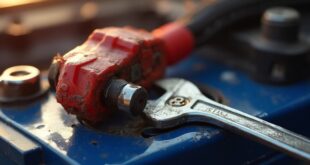A failing accelerator pedal sensor can lead to six notable issues. Drivers may experience an unresponsive accelerator pedal, car hesitation, and rough engine idling outside the ideal RPM range. Acceleration issues often arise, preventing speed increases despite pedal engagement. Additionally, shifting problems may occur due to incorrect sensor readings. These complications can lead to heightened fuel consumption. Understanding these signs is essential for maintaining vehicle performance and safety, as further insights on indicators await.
Unresponsive Accelerator Pedal
A malfunctioning accelerator pedal position sensor can lead to an unresponsive accelerator pedal, greatly affecting vehicle performance.
Drivers may notice that pressing the accelerator results in little to no response, causing frustration and potential safety issues. This symptom often coincides with an illuminated check engine light on the dashboard.
In addition, issues with shifting gears may arise, complicating the driving experience. Rough idling outside the ideal RPM range can also be observed, alongside increased fuel consumption.
These signs indicate the need for immediate inspection to prevent further complications and guarantee the vehicle operates efficiently and safely.
Car Hesitation
When experiencing car hesitation, drivers may notice a significant delay in the vehicle's response to pressing the gas pedal, which can be alarming. This condition often signals a failing accelerator pedal sensor and may lead to dangerous situations.
Recognizing the signs early can help prevent further complications. Key indicators include:
- A noticeable lag in acceleration when the pedal is pressed.
- Difficulty in maintaining speed during driving.
- Unexpected stalling or reduced power during acceleration.
- Increased likelihood of engine stuttering or jerking.
Consulting a mechanic promptly is advised to address these issues effectively.
Rough Idle
Although a smooth engine idle typically ranges between 600-700 RPM, a rough idle can indicate underlying issues with the accelerator pedal position sensor.
This irregularity can manifest as fluctuations in RPM, making it difficult for the engine to maintain a consistent idle. Unlike fuel mixture problems, a rough idle often stems from the sensor's inability to relay accurate position data, disrupting normal engine operation.
Monitoring the RPM is essential, as persistent rough idling may lead to further complications. Addressing the sensor promptly can prevent additional strain on the engine and enhance overall vehicle performance.
Regular diagnostics are advisable for best functioning.
Acceleration Issues
Acceleration issues often arise when the accelerator pedal position sensor fails, leading to inaccurate signals that disrupt engine performance. This malfunction can manifest in several noticeable ways, indicating a need for attention.
- Limited acceleration beyond a certain speed.
- Inability to increase speed despite pressing the gas pedal.
- Hesitation in response when engaging the accelerator.
- Potential safety hazards due to lack of acceleration.
Drivers should be vigilant for these signs, as they can compromise vehicle safety and performance.
Regular checks and timely repairs are essential to maintain ideal driving conditions.
Shifting Issues
Shifting issues can arise due to incorrect readings from a failing accelerator pedal position sensor, which affects the performance of the vehicle's transmission.
The sensor's failure can lead to delayed or erratic signals being sent to the transmission computer, complicating gear changes. As a result, the driver may experience inconsistent pedal response, making it difficult to shift smoothly between gears.
Additionally, the engine's mixture adjustments can be hindered by these faulty signals.
Regular diagnostics are suggested to guarantee the transmission functions properly and to prevent further complications that may arise from a malfunctioning accelerator pedal position sensor.
Fuel Consumption Variability
A noticeable decline in fuel efficiency can often signal a failing accelerator pedal position sensor. As the sensor malfunctions, it may send incorrect signals to the engine control unit, resulting in improper fuel mixture.
This can lead to various issues, including:
- Increased fuel consumption, straining the driver's budget.
- Engine receiving too much fuel, risking damage over time.
- Insufficient fuel delivery, causing performance issues.
- Erratic fuel efficiency, making it difficult to predict costs.
Timely repairs are essential to guarantee ideal fuel consumption and maintain engine health, preventing further complications down the road.
Frequently Asked Questions
How Can I Test My Accelerator Pedal Position Sensor?
To test the accelerator pedal position sensor, one should use a multimeter to measure resistance and voltage. Additionally, observing the sensor's response while pressing the pedal can reveal inconsistencies indicative of potential malfunction.
What Can Cause a Bad Accelerator Pedal Position Sensor?
Various factors can contribute to a malfunctioning accelerator pedal position sensor, including electrical issues, sensor wear or damage, poor connections, contamination from dirt or moisture, and exposure to extreme temperatures or vibrations affecting sensor performance.
Can a Faulty Sensor Affect Cruise Control?
A faulty sensor can disrupt cruise control functionality. It may lead to inconsistent speed maintenance, causing the system to disengage unexpectedly or fail to respond accurately to driver inputs, ultimately compromising overall driving safety and comfort.
Is It Safe to Drive With a Bad Sensor?
Driving with a bad sensor is generally unsafe. It can lead to unpredictable acceleration, gear shifting problems, and potential engine performance issues, increasing the risk of accidents. Consulting a mechanic for immediate evaluation is advisable.
How Much Does It Cost to Replace the Sensor?
The cost to replace an accelerator pedal sensor typically ranges from $100 to $400, depending on the vehicle make and model, labor rates, and whether original equipment or aftermarket parts are used for replacement.
 Car Service Land Coupons for Oil change, Tires, Wheel alignment, Brakes, Maintenance
Car Service Land Coupons for Oil change, Tires, Wheel alignment, Brakes, Maintenance




